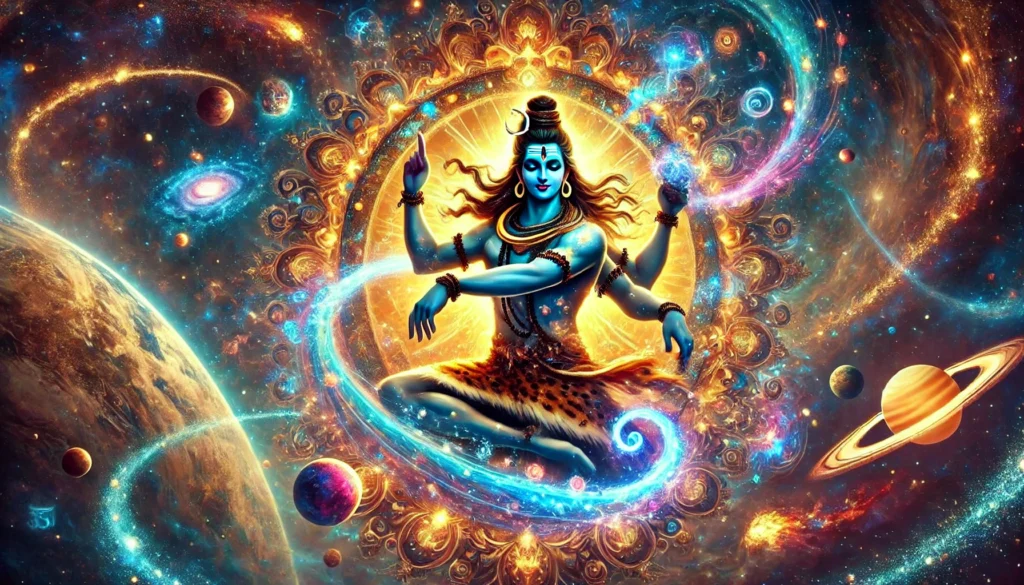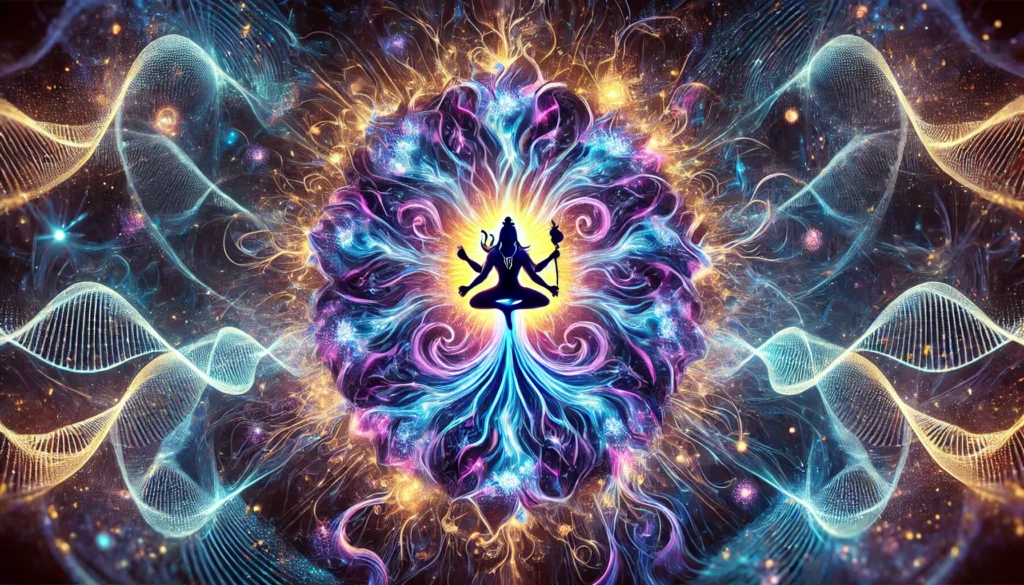Introduction
Could ancient mythology hold the keys to understanding the universe’s deepest mysteries? Across cultures and ages, humans have sought to comprehend existence through spirituality and science. In Hindu philosophy, Lord Shiva—depicted as Nataraja, the cosmic dancer—symbolizes the rhythmic interplay of creation, preservation, and destruction. Surprisingly, this age-old symbolism aligns with principles in modern quantum physics, a field that delves into the microscopic workings of our universe.
This blog explores how Shiva’s cosmic dance (Shiva’s Dance) and quantum physics reveal the universe’s interconnected nature, blending mythology and science into a unified narrative. From the iconography of Nataraja to parallels in subatomic motion, we uncover insights that bridge the ancient and modern worlds.

Table of Contents
- Understanding Shiva as Nataraja
- The Iconography of Nataraja
- The Symbolism of the Cosmic Dance
- The Cycles of Creation, Preservation, and Destruction
- Quantum Physics: The Foundations
- Wave-Particle Duality
- Quantum Entanglement
- The Role of Observers
- Parallels Between Shiva’s Dance and Quantum Mechanics
- Subatomic Motion and the Tandava Dance
- Energy Transformations in Quantum Physics
- Wave-Particle Dynamics in the Cosmic Dance
- Modern Science Meets Mythology
- Nataraja at CERN
- Hindu Cosmology in Modern Physics
- Physicists’ Reflections on Nataraja
- Philosophical Implications
- Universal Interconnectedness
- Transformation as a Core Principle
- Bridging Spirituality and Science
- Frequently Asked Questions
- Conclusion
1. Understanding Shiva as Nataraja
The Iconography of Nataraja
The image of Nataraja is one of Hinduism’s most enduring symbols, representing Lord Shiva as the cosmic dancer. Each aspect of the Nataraja statue carries profound meaning:
- Damru (Drum): Held in Shiva’s right hand, the damru symbolizes the sound of creation, the primordial vibration (“Om”) from which the universe emerged.
- Fire: In his left hand, Shiva holds fire, signifying destruction and transformation. Without destruction, there can be no new creation.
- Circle of Flames (Prabhamandala): The encircling flames represent the cyclical nature of the universe: creation, preservation, destruction, and rebirth.
- Raised Leg: Shiva’s raised leg symbolizes liberation, offering an escape from the cycle of life and death.
- Subjugated Demon (Apasmara): Beneath Shiva’s foot lies a demon representing ignorance, trampled by knowledge and enlightenment.
The Symbolism of the Cosmic Dance
Shiva’s dance, the Tandava, is more than a mythological tale; it is a profound allegory for the cosmic processes that govern the universe. His rhythmic movements depict the balance of opposing forces—creation and destruction, order and chaos—maintaining the universe’s equilibrium.
The Cycles of Creation, Preservation, and Destruction
In Hindu philosophy, the universe operates as a triadic cycle governed by Brahma (creator), Vishnu (preserver), and Shiva (destroyer). This cyclical nature mirrors scientific concepts like the conservation of energy, where energy is neither created nor destroyed but constantly transformed.

2. Quantum Physics: The Foundations
Wave-Particle Duality
At the heart of quantum physics lies the dual nature of light and matter. Subatomic particles, such as electrons, behave as both particles and waves. This duality defies classical logic, much like the paradoxical roles embodied by Shiva’s dance—simultaneously creating and destroying.
Quantum Entanglement
Quantum entanglement describes a phenomenon where particles remain interconnected regardless of distance. When one particle is affected, its entangled partner reacts instantly, challenging our understanding of time and space. This interconnectedness resonates with the idea that Shiva’s dance unites all aspects of the cosmos.
The Role of Observers
In quantum mechanics, the act of observation influences a particle’s state, collapsing its wave function into a definitive reality. This interplay between observer and observed parallels philosophical ideas of consciousness and its role in shaping reality, as emphasized in Hindu cosmology.
3. Parallels Between Shiva’s Dance and Quantum Mechanics
Subatomic Motion and the Tandava Dance
The Tandava’s dynamic and cyclical movements mirror the ceaseless activity of subatomic particles. Electrons orbit nuclei, quarks vibrate within protons and neutrons, and particles spontaneously emerge and vanish in quantum fields. This constant motion evokes the vitality of Shiva’s dance.
Energy Transformations in Quantum Physics
Shiva’s dance symbolizes energy’s transformative nature. In quantum mechanics, particles transition between states, embodying creation, preservation, and destruction:
- Creation: Virtual particles emerge from quantum fields.
- Preservation: Particles maintain stability within atomic structures.
- Destruction: Annihilation occurs when matter meets antimatter.
These processes align with the symbolic elements of Nataraja’s iconography.
Wave-Particle Dynamics in the Cosmic Dance
Just as Shiva’s dance harmonizes opposing forces, quantum entities exhibit wave-particle duality. The wave represents potential, while the particle signifies manifestation, echoing the dance’s duality of creation and destruction.

4. Modern Science Meets Mythology
Nataraja at CERN
The European Organization for Nuclear Research (CERN) recognizes Nataraja’s relevance to modern science. A statue of Shiva as Nataraja stands prominently at CERN, symbolizing the harmony between ancient philosophy and contemporary physics. The plaque beneath it reads: “Shiva’s cosmic dance is a metaphor for the dynamic interplay of creation and destruction in the universe.”
Hindu Cosmology in Modern Physics
Hindu cosmology’s cyclical view of the universe aligns with scientific theories like the Big Bang and Big Crunch. The expansion and contraction of the universe reflect the oscillating rhythms of Shiva’s dance.
Physicists’ Reflections on Nataraja
Physicists like Fritjof Capra, author of The Tao of Physics, have drawn direct comparisons between Nataraja’s dance and quantum phenomena. Capra writes, “Every subatomic particle not only performs an energy dance but also is an energy dance.” This poetic depiction underscores the symbolic unity between Shiva’s Tandava and the quantum realm.
5. Philosophical Implications
Universal Interconnectedness
The concept of interconnectedness is central to both Hindu philosophy and quantum mechanics. In Shiva’s dance, every movement influences the whole, mirroring how quantum entanglement binds particles across vast distances.
Transformation as a Core Principle
Shiva’s dance embodies transformation, emphasizing that destruction is not an end but a precursor to renewal. Similarly, quantum physics reveals that change is intrinsic to the universe, with particles constantly transitioning between states.
Bridging Spirituality and Science
By exploring parallels between Nataraja and quantum physics, we see a convergence of spirituality and science. Both realms seek to understand existence’s mysteries, offering complementary perspectives on the universe’s intricate dance.
6. Frequently Asked Questions
Q: What is the cosmic dance of Shiva? The cosmic dance of Shiva, or Tandava, represents the cyclical processes of creation, preservation, and destruction, symbolizing the universe’s dynamic equilibrium.
Q: How does Nataraja relate to quantum physics? Nataraja embodies dynamic energy and transformation, mirroring quantum phenomena such as wave-particle duality and energy conservation.
Q: Why is Nataraja significant to modern science? The Nataraja symbolizes the interplay of cosmic forces, aligning with modern physics’ understanding of the universe’s dynamic nature.
Q: What does the circle of flames represent? The circle of flames encircling Nataraja signifies the eternal cycle of creation, preservation, and destruction.
7. Conclusion
Shiva’s cosmic dance and quantum physics unveil a shared truth: the universe is an intricate, interconnected web of dynamic forces. By bridging ancient symbolism with modern science, we deepen our understanding of existence, transcending the boundaries of myth and reality. Could the Tandava inspire new paradigms in both science and spirituality? Perhaps, in embracing this cosmic dance, we find not only answers but also a deeper appreciation for the universe’s boundless mysteries.
